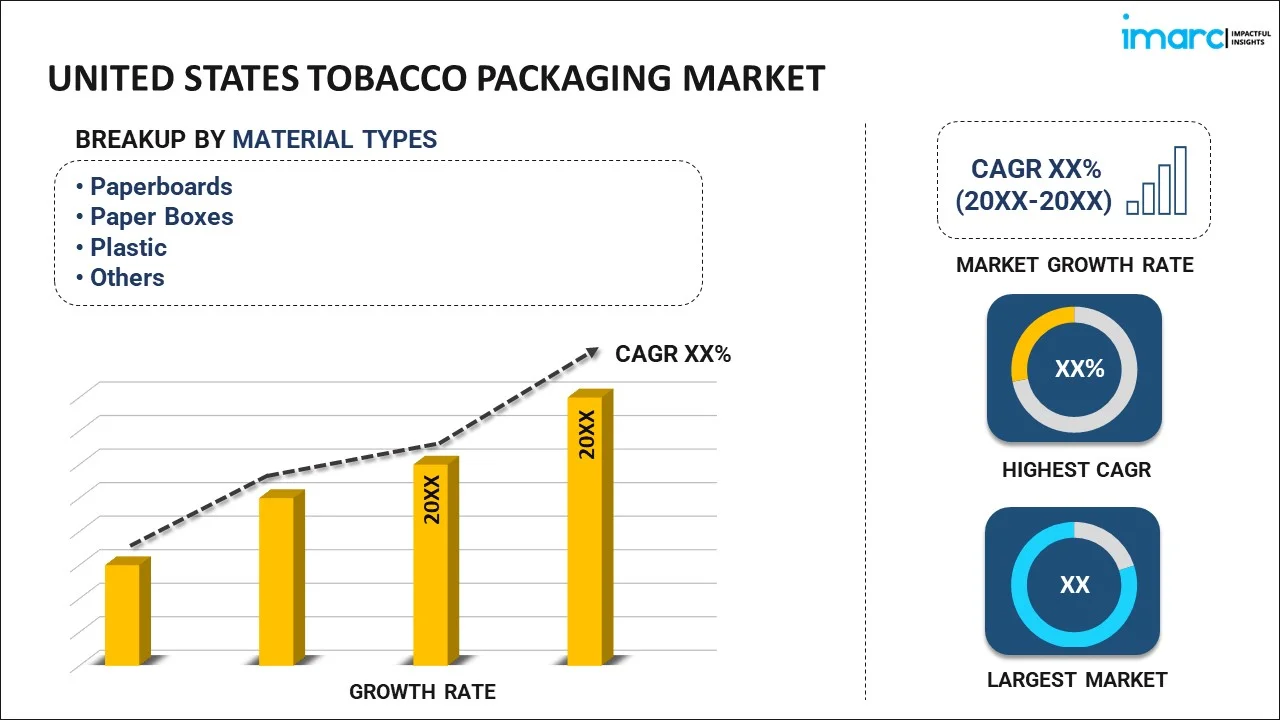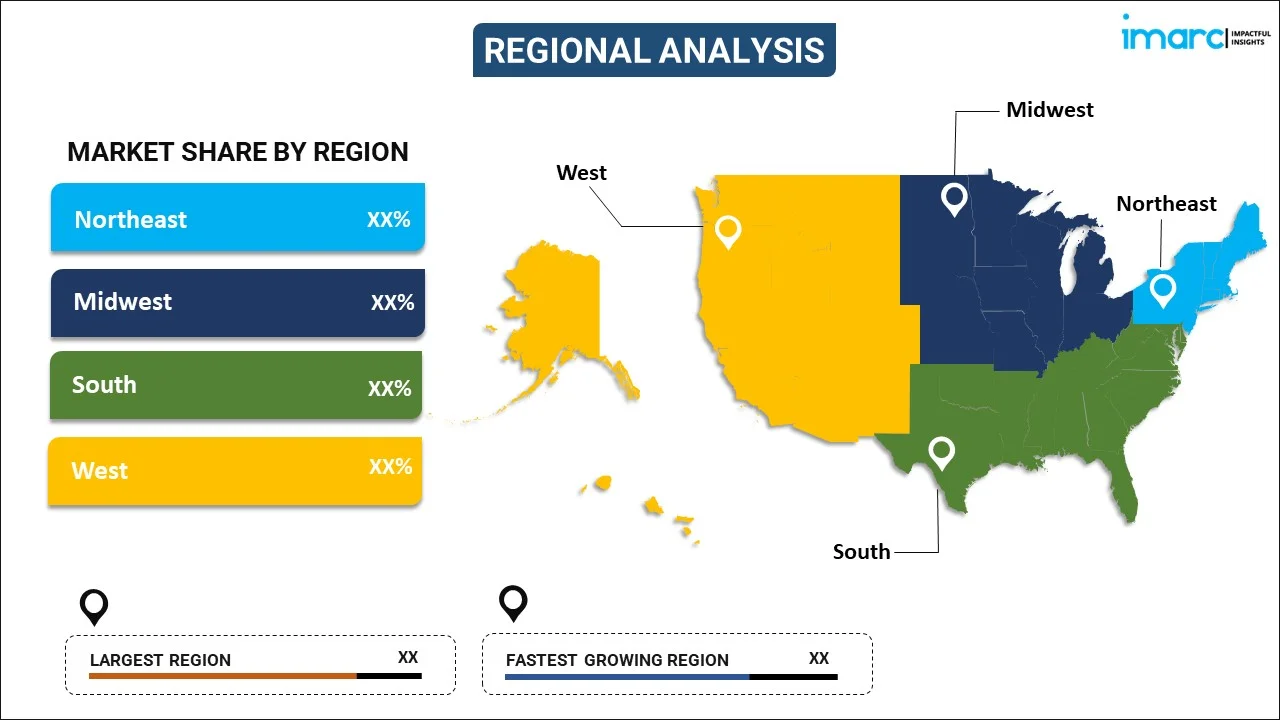
United States Tobacco Packaging Market Report by Material Type (Paperboards, Paper Boxes, Plastic, Jute, Metal, and Others), Packaging Type (Primary Packaging, Secondary Packaging, Bulk Packaging), End Use (Smoking Tobacco, Smokeless Tobacco, Raw Tobacco), and Region 2024-2032
Market Overview:
The United States tobacco packaging market size is projected to exhibit a growth rate (CAGR) of 3.62% during 2024-2032. The implementation of stringent regulatory landscape surrounding the packaging of tobacco, the introduction of biodegradable and eco-friendly packaging options, and the growth of e-commerce and online sales channels represent some of the key factors driving the market.
|
Report Attribute
|
Key Statistics
|
|---|---|
|
Base Year
|
2023 |
|
Forecast Years
|
2024-2032
|
|
Historical Years
|
2018-2023
|
| Market Growth Rate (2024-2032) | 3.62% |
Tobacco packaging refers to the materials and design used to package and present tobacco products, primarily cigarettes, cigars, and smokeless tobacco. The packaging of tobacco products serves multiple purposes, including containing and protecting the tobacco, complying with legal and regulatory requirements, and influencing consumer behavior. Tobacco packaging is designed to securely contain and protect the tobacco product. It prevents exposure to moisture, light, and air, which can degrade the quality of the tobacco. It typically includes branding elements, such as the product name, logo, and manufacturer's information. These elements help consumers identify and differentiate between different tobacco brands and variants. Tobacco packaging materials can vary but are typically made of paper or cardboard. The materials are chosen for their ability to protect the product while also allowing for printing and labeling. Moreover, in some regions, tax stamps are affixed to tobacco packaging to indicate that the appropriate taxes have been paid. These stamps help authorities track and regulate the sale of tobacco products.
United States Tobacco Packaging Market Trends:
One of the primary drivers of market is the stringent regulatory environment surrounding tobacco products. Federal and state laws require the inclusion of prominent and graphic health warnings on cigarette and smokeless tobacco packaging. These warnings aim to inform consumers about the health risks associated with tobacco use and deter smoking. As regulations evolve and health warnings are periodically updated, tobacco companies must invest in packaging solutions that comply with these requirements, driving innovation in packaging design and materials. In addition, despite the limitations imposed by health warning regulations, brand identity remains crucial in the tobacco industry. Packaging serves as a vital tool for differentiating products and establishing brand recognition. Effective branding can influence consumer preferences and loyalty. As a result, tobacco companies invest in packaging that maintains brand consistency and appeal while adhering to legal constraints. Besides, the pursuit of packaging solutions that balance compliance, brand appeal, and sustainability leads to ongoing innovation in materials. Tobacco companies seek alternatives to traditional packaging materials that are both functional and environmentally responsible. This drive for innovation has led to the exploration of biodegradable and eco-friendly packaging options. Furthermore, the growth of e-commerce and online sales channels has prompted tobacco companies to adapt their packaging strategies. Packaging for online sales needs to ensure product integrity during shipping and delivery while complying with regulations. Companies invest in solutions that address the unique challenges of e-commerce packaging, such as protecting against damage and minimizing exposure to minors.
United States Tobacco Packaging Market Segmentation:
IMARC Group provides an analysis of the key trends in each segment of the market, along with forecasts at the country level for 2024-2032. Our report has categorized the market based on material type, packaging type, and end use.
Material Type Insights:

- Paperboards
- Paper Boxes
- Plastic
- Jute
- Metal
- Others
The report has provided a detailed breakup and analysis of the market based on the material type. This includes paperboards, paper boxes, plastic, jute, metal, and others.
Packaging Type Insights:
- Primary Packaging
- Secondary Packaging
- Bulk Packaging
A detailed breakup and analysis of the market based on the packaging type have also been provided in the report. This includes primary packaging, secondary packaging, and bulk packaging.
End Use Insights:
- Smoking Tobacco
- Cigarettes
- Cigars
- Smokeless Tobacco
- Chewing Tobacco
- Snuff
- Dissolvable Tobacco
- Others
- Raw Tobacco
The report has provided a detailed breakup and analysis of the market based on the end use. This includes smoking tobacco (cigarettes and cigars), smokeless tobacco (chewing tobacco, snuff, dissolvable tobacco, and others), and raw tobacco.
Regional Insights:

- Northeast
- Midwest
- South
- West
The report has also provided a comprehensive analysis of all the major regional markets, which include the Northeast, Midwest, South, and West.
Competitive Landscape:
The market research report has also provided a comprehensive analysis of the competitive landscape in the market. Competitive analysis such as market structure, key player positioning, top winning strategies, competitive dashboard, and company evaluation quadrant has been covered in the report. Also, detailed profiles of all major companies have been provided.
United States Tobacco Packaging Market Report Coverage:
| Report Features | Details |
|---|---|
| Base Year of the Analysis | 2023 |
| Historical Period | 2018-2023 |
| Forecast Period | 2024-2032 |
| Units | Million US$ |
| Scope of the Report | Exploration of Historical and Forecast Trends, Industry Catalysts and Challenges, Segment-Wise Historical and Predictive Market Assessment:
|
| Material Types Covered | Paperboards, Paper Boxes, Plastic, Jute, Metal, Others |
| Packaging Types Covered | Primary Packaging, Secondary Packaging, Bulk Packaging |
| End Uses Covered |
|
| Regions Covered | Northeast, Midwest, South, West |
| Customization Scope | 10% Free Customization |
| Report Price and Purchase Option | Single User License: US$ 3699 Five User License: US$ 4699 Corporate License: US$ 5699 |
|
Post-Sale Analyst Support |
10-12 Weeks |
| Delivery Format | PDF and Excel through Email (We can also provide the editable version of the report in PPT/Word format on special request) |
Key Questions Answered in This Report:
- How has the United States tobacco packaging market performed so far and how will it perform in the coming years?
- What has been the impact of COVID-19 on the United States tobacco packaging market?
- What is the breakup of the United States tobacco packaging market on the basis of material type?
- What is the breakup of the United States tobacco packaging market on the basis of packaging type?
- What is the breakup of the United States tobacco packaging market on the basis of end use?
- What are the various stages in the value chain of the United States tobacco packaging market?
- What are the key driving factors and challenges in the United States tobacco packaging?
- What is the structure of the United States tobacco packaging market and who are the key players?
- What is the degree of competition in the United States tobacco packaging market?
Key Benefits for Stakeholders:
- IMARC’s industry report offers a comprehensive quantitative analysis of various market segments, historical and current market trends, market forecasts, and dynamics of the United States tobacco packaging market from 2018-2032.
- The research report provides the latest information on the market drivers, challenges, and opportunities in the United States tobacco packaging market.
- Porter's five forces analysis assist stakeholders in assessing the impact of new entrants, competitive rivalry, supplier power, buyer power, and the threat of substitution. It helps stakeholders to analyze the level of competition within the United States tobacco packaging industry and its attractiveness.
- A competitive landscape allows stakeholders to understand their competitive environment and provides an insight into the current positions of key players in the market.
Need more help?
- Speak to our experienced analysts for insights on the current market scenarios.
- Include additional segments and countries to customize the report as per your requirement.
- Gain an unparalleled competitive advantage in your domain by understanding how to utilize the report and positively impacting your operations and revenue.
- For further assistance, please connect with our analysts.
 Inquire Before Buying
Inquire Before Buying
 Speak to an Analyst
Speak to an Analyst
 Request Brochure
Request Brochure
 Request Customization
Request Customization




.webp)




.webp)












